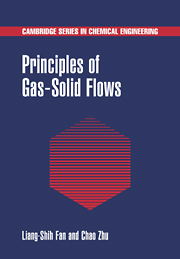Book contents
- Frontmatter
- Contents
- Preface
- Part I Basic Relationships
- Part II System Characteristics
- 7 Gas–Solid Separation
- 8 Hopper and Standpipe Flows
- 9 Dense-Phase Fluidized Beds
- 10 Circulating Fluidized Beds
- 11 Pneumatic Conveying of Solids
- 12 Heat and Mass Transfer Phenomena in Fluidization Systems
- Appendix: Summary of Scalar, Vector, and Tensor Notation
- Index
8 - Hopper and Standpipe Flows
from Part II - System Characteristics
Published online by Cambridge University Press: 27 October 2009
- Frontmatter
- Contents
- Preface
- Part I Basic Relationships
- Part II System Characteristics
- 7 Gas–Solid Separation
- 8 Hopper and Standpipe Flows
- 9 Dense-Phase Fluidized Beds
- 10 Circulating Fluidized Beds
- 11 Pneumatic Conveying of Solids
- 12 Heat and Mass Transfer Phenomena in Fluidization Systems
- Appendix: Summary of Scalar, Vector, and Tensor Notation
- Index
Summary
Introduction
Granular materials in the food, pharmaceutical, chemical, and fuel industries are routinely processed through hoppers and standpipes. When the solids flow in a vertical or inclined pipe is dominated by gravity and the solids are in a nearly packed condition, the flow is known as a standpipe flow or downcomer flow. In a standpipe flow, the cross-sectional area of the standpipe is unchanged and the gas pressure at the bottom is higher than that at the top. The downward transport may also be achieved with higher pressure at the top. In this case, the solids transport is referred to as a discharged flow. The discussion of discharged flow is, however, beyond the scope of this chapter; readers interested in discharged flow may refer to the work of Berg (1954), and Knowlton et al. (1986, 1989).
Hoppers can be classified into two categories, namely, mass flow hoppers and core (or funnel) flow hoppers. A mass flow hopper is characterized by the simultaneous movement of every particle of the material during the discharge process, as shown in Fig. 8.1(a). On the other hand, in a core flow hopper, there exist stagnation zones in the material discharge process, as shown in Fig. 8.1(b). Advantages of mass flow hoppers are overwhelming compared to those of core flow hoppers. Problems like flooding, segregation, inconsistent flow rate, arching, and piping are less likely to occur in mass flow hoppers.
- Type
- Chapter
- Information
- Principles of Gas-Solid Flows , pp. 333 - 370Publisher: Cambridge University PressPrint publication year: 1998



